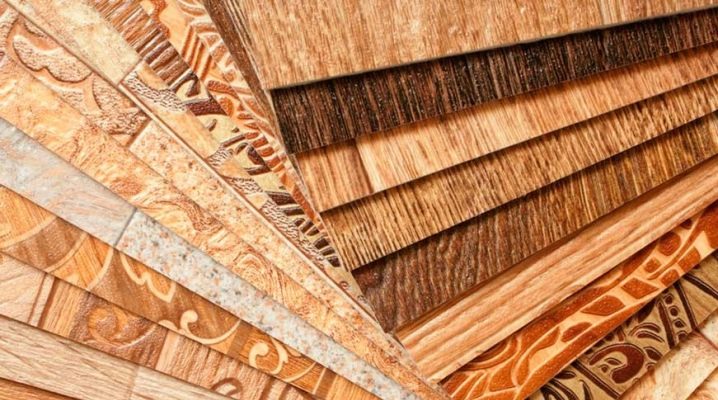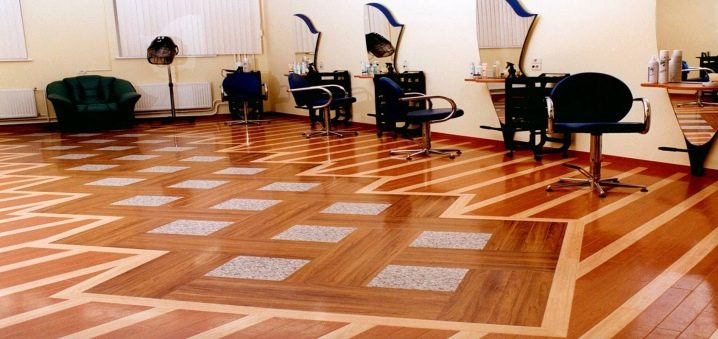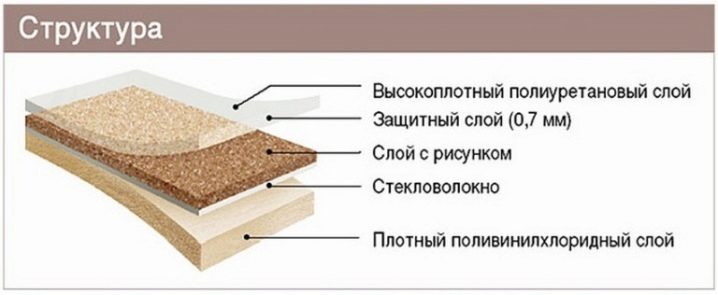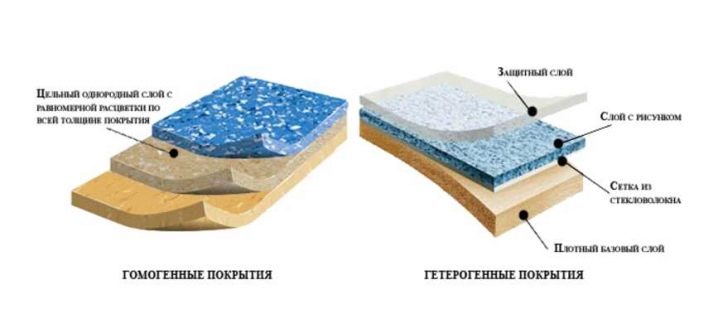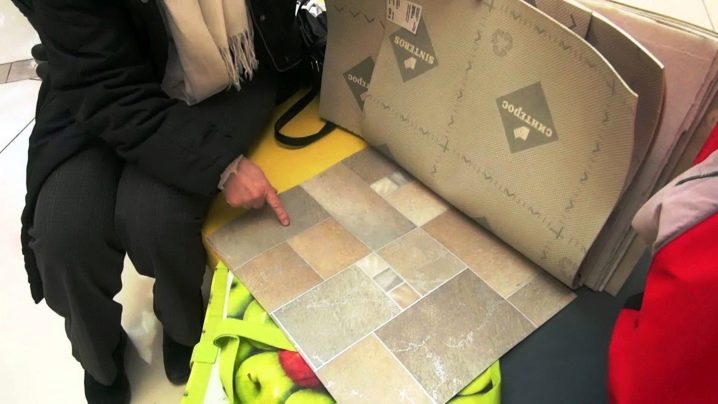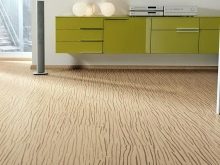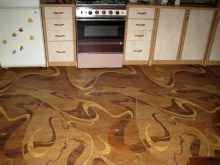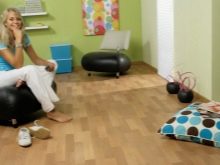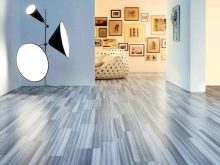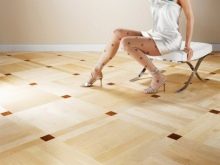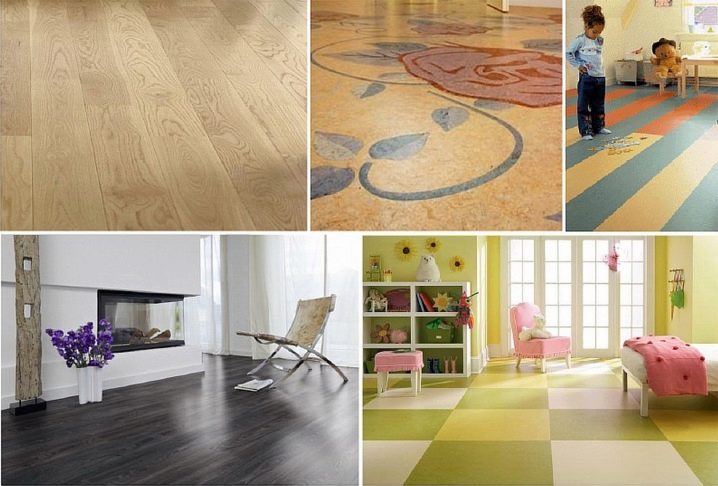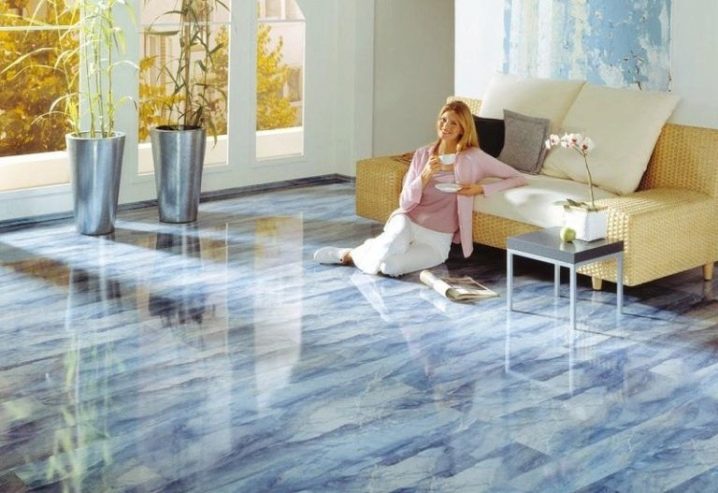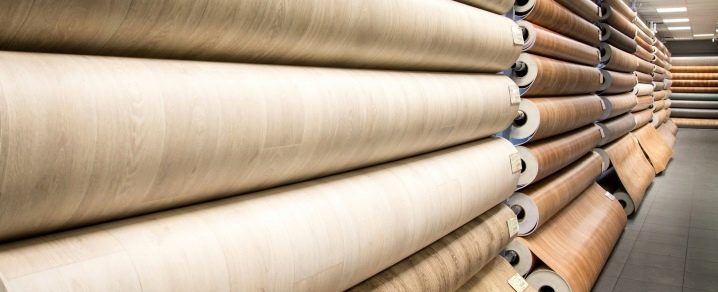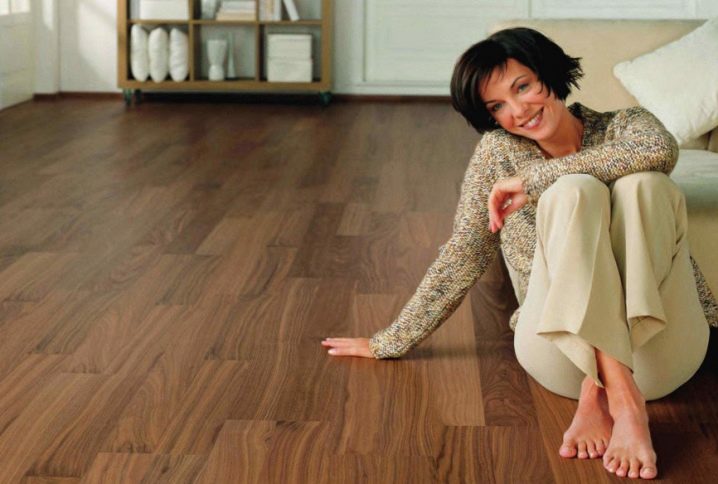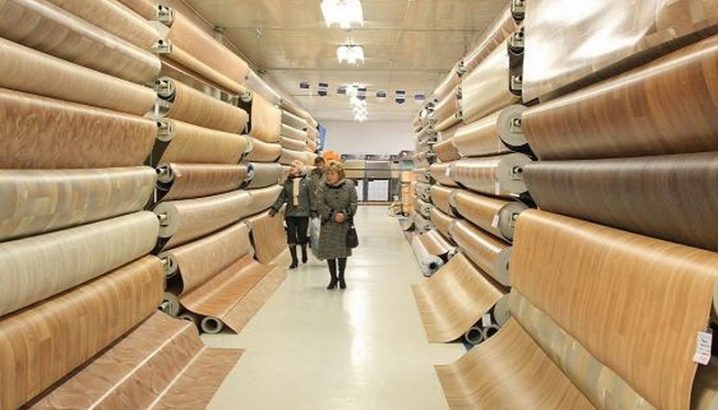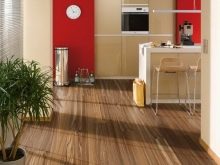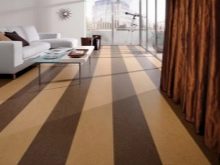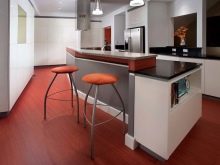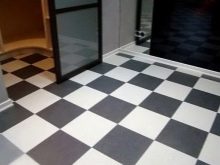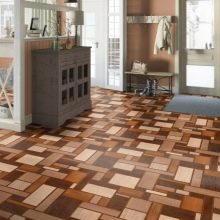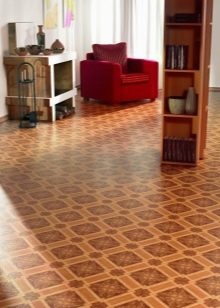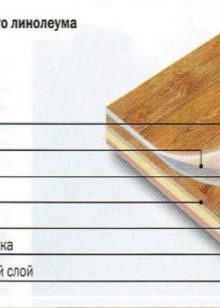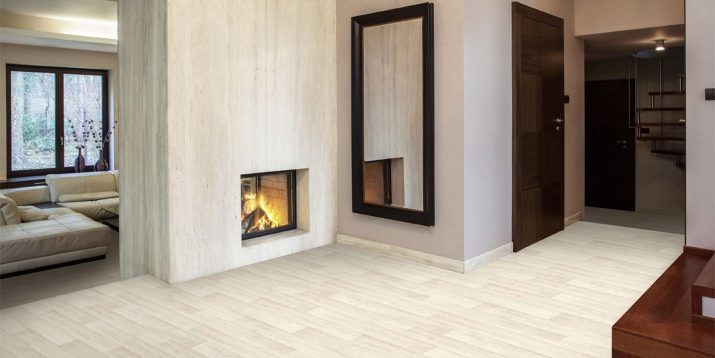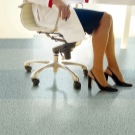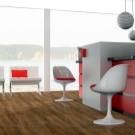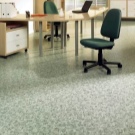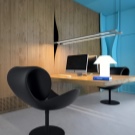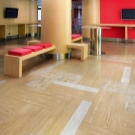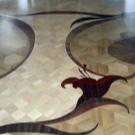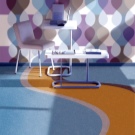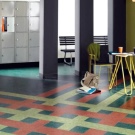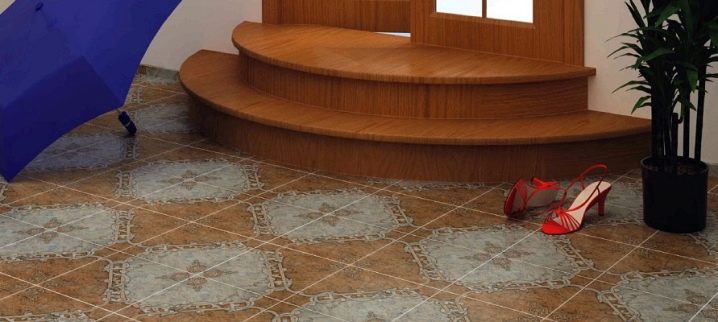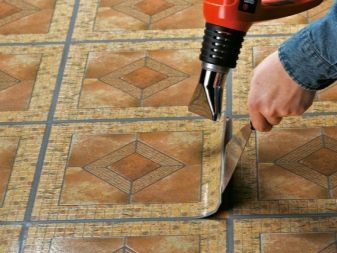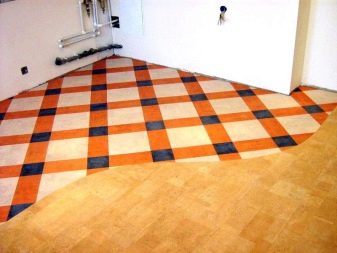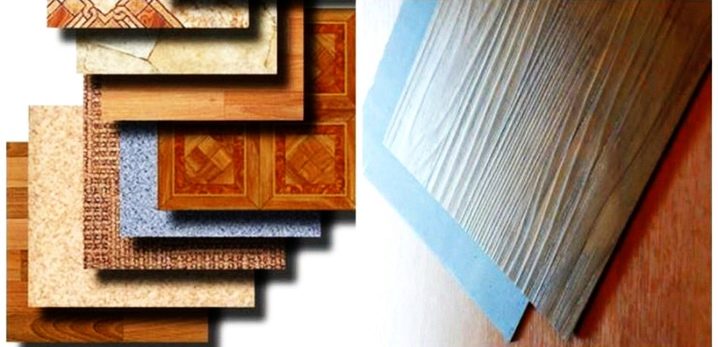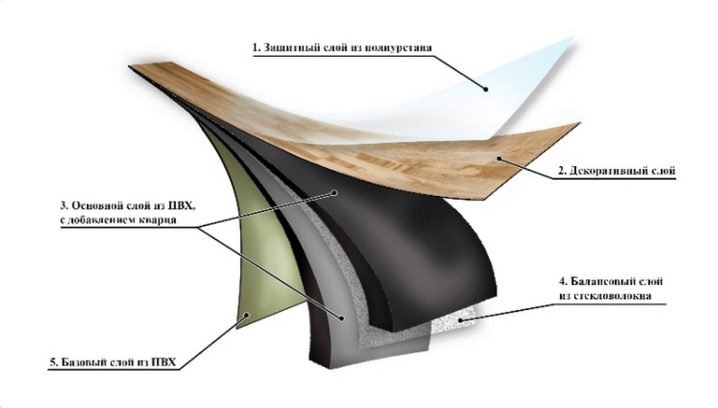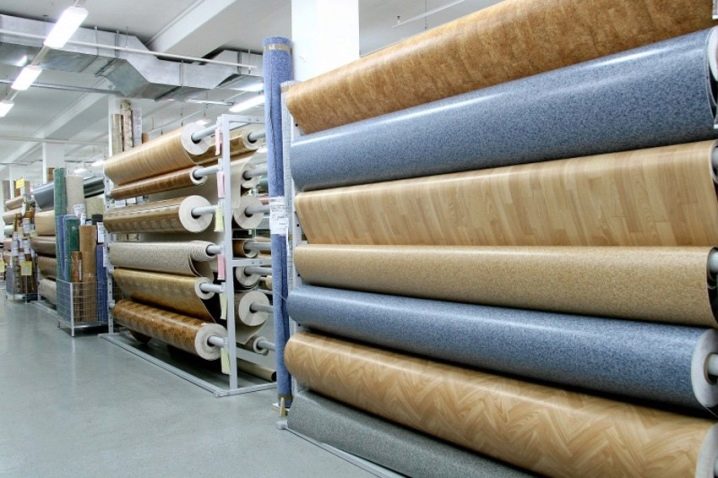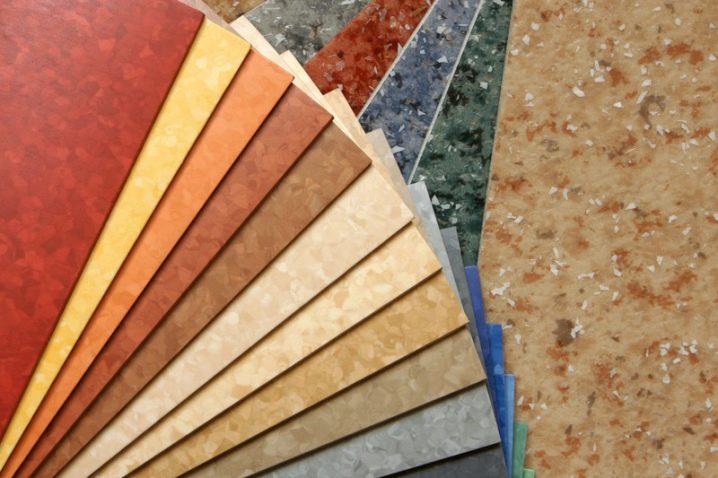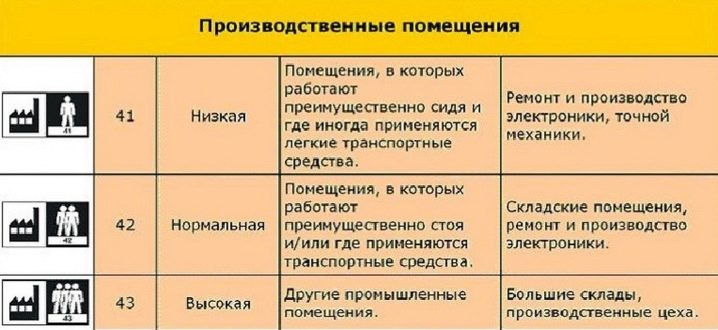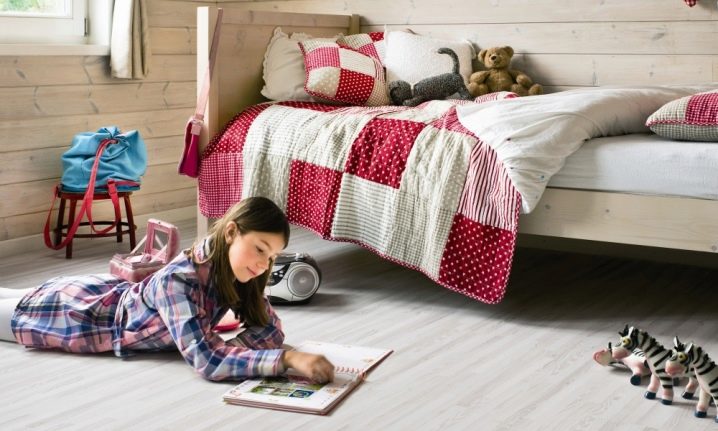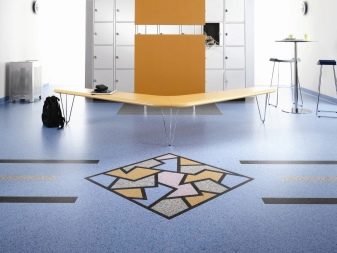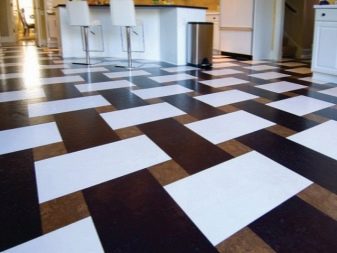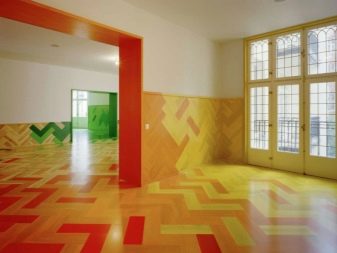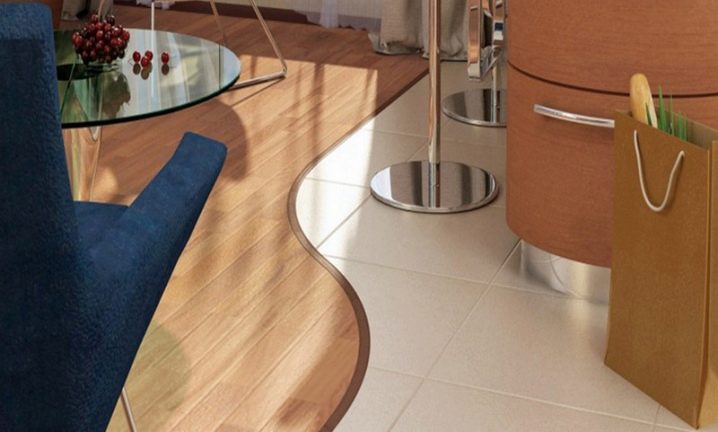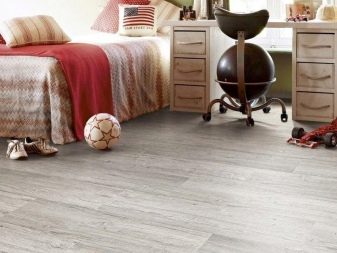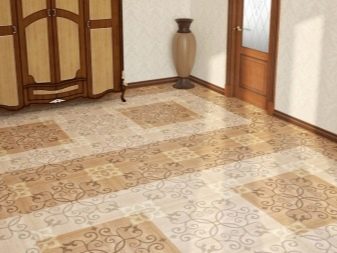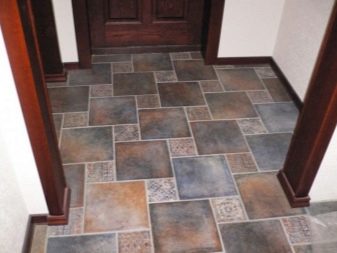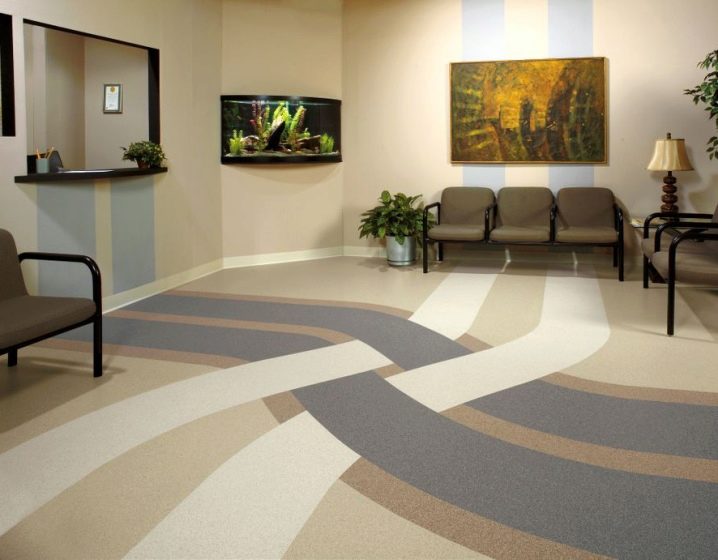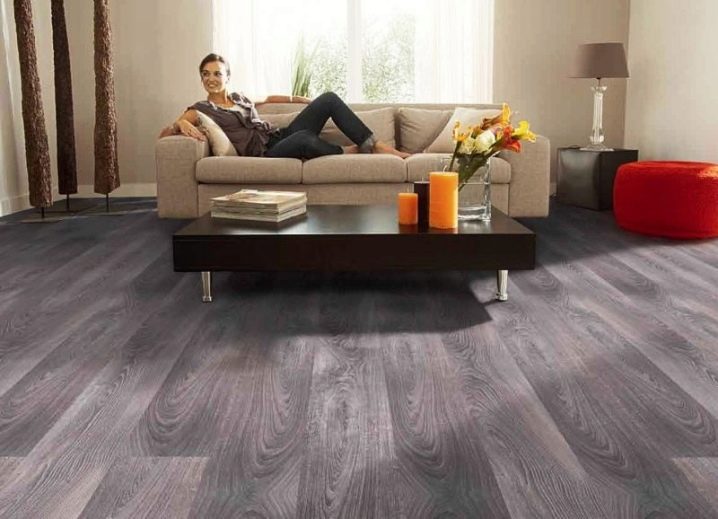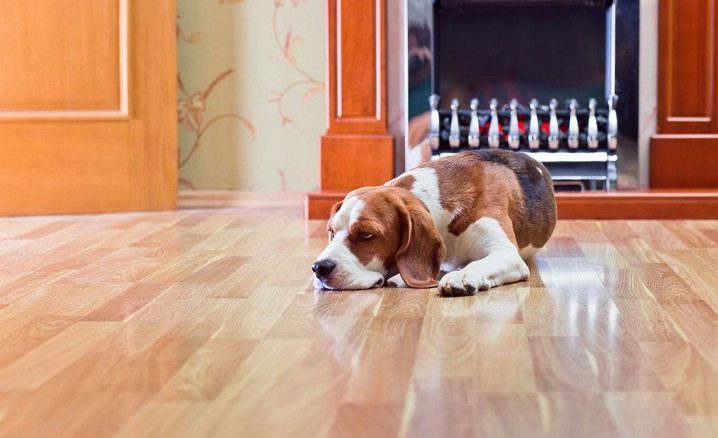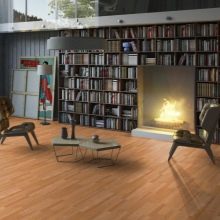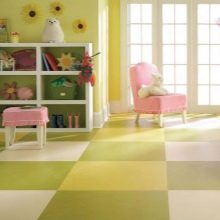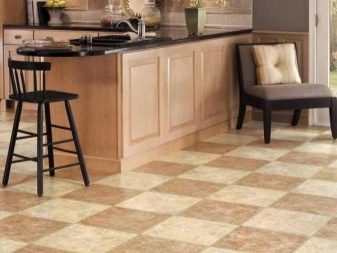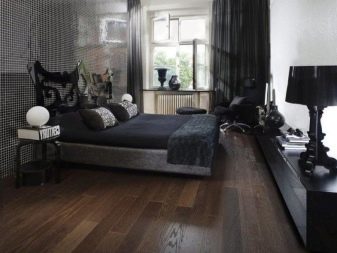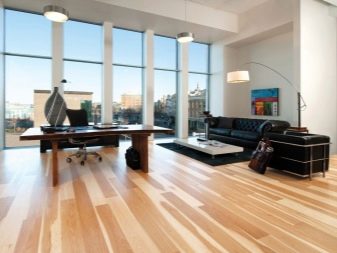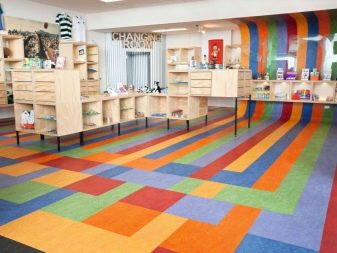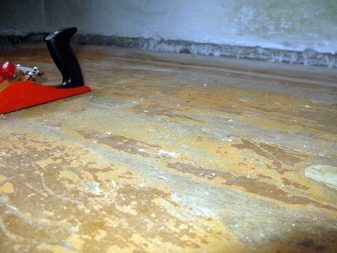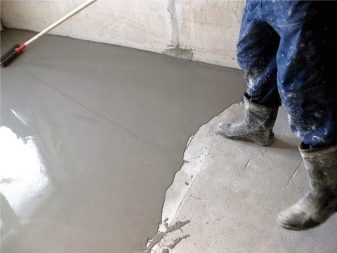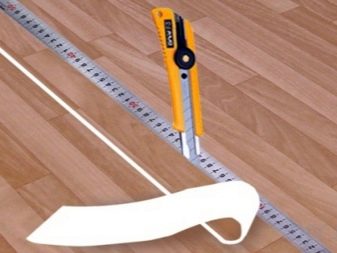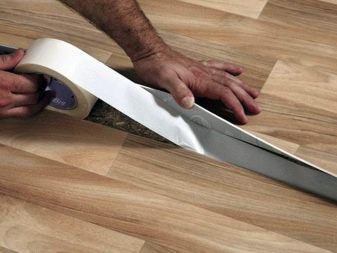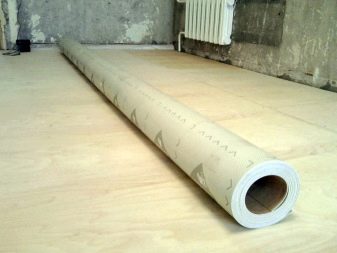Choosing linoleum
Facing the floor of the home - a key factor in the repair. The main background of the interior composition depends on the flooring. It is important that the material meets safety requirements and is suitable for everyday use. Among the mass of expensive floor finishes, linoleum is especially popular with buyers. When choosing a coating, it is necessary to examine its strengths and weaknesses.
What it is?
Linoleum is a finishing material of natural or artificial origin. It is a cloth, uniformly wound on a roll. Initially, linoleum was developed as an alternative to expensive floor finishes (parquet, tile and floorboard).
Thanks to the development of modern technologies, it has become much better than laminate, which in essence is a fiberboard with a protective layer and swells during prolonged contact with water.
The structure of linoleum is different, but in most cases it is multi-layered and consists of:
- bottom backing layer with the logo of the brand;
- foamed base;
- primed carrier layer (fiberglass);
- facial layer;
- decorative layer;
- transparent protection (wear layer);
- additional protective layer of polyurethane.
The structure of the material may be homogeneous or heterogeneous.
In the first case, monolithic linoleum (all layers are crushed into one), so the pattern of the floor covering permeates the entire thickness and is erased as slowly as possible. In the second case, the layers differ in appearance, which can be seen by looking at the material cut close.
Each structure is unique in its own way, so in any line you can choose a quality coating that will have a long service life and high performance.
Advantages and disadvantages
The choice of linoleum is based on the study of strengths and weaknesses. This knowledge is necessary in order to understand the degree of relevance of coverage in a particular room, taking into account the cross-country area and durability of the material.
Modern linoleum differs from the analogs of the Soviet era. If before it was not given due attention, today floor decoration combines the best qualities of the coating with excellent aesthetic perception. This is a repair tool and an element indicating the status of homeowners.
The main advantages of the material include:
- simple installation and versatility of use in residential and non-residential premises (in the lining of the living room, nursery, bathroom, toilet, office, shop, office, salon, cafe, clinic, restaurant, balcony and others);
- the variability of the width, allowing the installation of the floor without joints and trimming a large amount of material (cost savings when buying);
- a large assortment of colors with realistic imitation of expensive floor materials (for parquet, parquet, laminate, ceramic tile, porcelain stoneware, marble chips, etc.) and modest ornamental style;
- a variety of surface texture, so that the coating can be smooth, glossy, noble matte, embossed (with 3D effect), rough;
- the presence of an additional antistatic effect, which explains the repulsion of dust and resistance to dirt, absorption of stains;
- the durability of the floor covering, which, depending on the class of material and operating conditions, can be up to 40 years without cracking and wiping the surface;
- based on the characteristics of the composition, compatibility with the system "warm floor", the ability to evenly distribute heat through the structure throughout the floor;
- high heat-insulating properties and noise insulation, due to which the audibility of annoying extraneous sounds from neighboring apartments can be reduced;
- depending on the class resistance to wear (the level of maximum permissible weight load without forcing the surface);
- resistance to moisture when exposed to the front side;
- simple care and resistance to daily cleaning (just wipe the surface with a damp cloth), as well as household chemicals;
- the richest color palette, through which you can beat the lack of space or lighting, consider practicality, or demonstrate status;
- different cost of material, based on its composition, the level of premium, the number and width of the cut.
The advantage of the material is the factthat carpet can be put on an old floor: this is a great way to restore the floor if the surface of the old floor does not have an abundance of blisters, waves and is well glued to the floor.
With a lot of advantages, not every type of linoleum is worth buying. Despite the assurances of sellers and promising advertising, linoleum has drawbacks.
Among the main can be noted:
- the presence of synthetic components, which suits not every buyer;
- cost increase with an increase in the thickness of the protective layer of the surface;
- complex transportation with a large volume and weight, the possibility of the formation of defects in the delivery process;
- reacting to constant temperature drops, which changes the structure, depriving it of elasticity and leading to the formation of cracks on the face of the material;
- the boring type of material of a simple class, which simplifies the general view of a room's decor, at the expense of ornaments creates a feeling of variegation and confusion;
- the difficulty of some varieties of coatings, the formation of waves after laying and gluing to the surface;
- the need for docking in the laying of spacious rooms, the area of which is much larger than the maximum produced width;
- the presence of weak points (joints), which, upon the ingress of water, can break the monolithic appearance of the floor covering and require a correction using the method of pasting or has ceased;
- the formation of mold from the wrong side with prolonged contact of the base with water without proper drying of the material;
- leveling the surface of the floor before laying.
What are the types of sex?
Linoleum has a lot of varieties of flooring, different in structure. The most popular type of material is a canvas based on polymers, consisting of polyvinyl chloride (abbreviated as PVC). It is strong, durable and like to buyers for its high practical characteristics.
In addition to him on the shelves of building stores you can find linoleum:
- natural, which consists of oil of flax, which has undergone oxidation, resins of deciduous trees, flour of wood origin, limestone, jute, natural dyes (the material does not have a pattern, is performed in one color, is particularly durable and has antibacterial properties);
- glyptalmade on the basis of alkyd resins with different additives and color pigments (a good insulating material,however, it is characterized by relatively small elasticity, therefore it is prone to the formation of cracks);
- rubberconsisting of two layers: for the top, new rubber is used, the bottom consists of rubber waste products (a particularly elastic material that is most resistant to moisture).
The entire range of linoleum coating produced is divided into three groups.
Linoleum happens:
- household;
- semi-commercial;
- commercial.
Division into subspecies due to quality characteristics.
Household linoleum - the easiest. According to its properties, it is inferior to analogs: it is simpler, often does not have a beautiful appearance, has an extremely porous and smooth surface, is devoid of additional effects. This is a cheap material, which is designed for rooms with low traffic. The drawings are more often motley, stylized, not fitting into every interior.
Semi-commercial version of the material - a step above. Its external and operational characteristics are better: it is resistant to heavy loads, scratches, cracks, creases, it has an elastic structure, it looks beautiful and often imitates expensive flooring made from paving stones or stone.The drawings are premium, the surface is varied: it can be textured with a relief, matte, rough, have anti-slip effect.
This material is intended for rooms with medium and large traffic.
Commerce - a high level of linoleum flooring, is the best grade of this finish. Its front side looks like a half-measure. It looks expensive, has a textured surface, has antimicrobial impregnation, often natural components, sometimes it is performed with a 3D effect. Commercial linoleum is designed for high throughput: it was originally created for industrial premises where the load on the work surface is enormous.
High characteristics of quality and reliability led to the use of flooring in residential apartments and country houses.
Linoleum tile - the original appearance of the flooring in the form of tiles. This is a kind of modular mosaic, which is laid on the floor like a ceramic tile. Fragments are usually small, square (in the form of tiles) or rectangular (like boards) forms.By structure, texture, colors, they do not differ from the analogue of the roll type. Here is the same classification, qualitative and practical characteristics.
External data and protection are subject to the general rules (the more expensive, the more premium). Sometimes the fragments have such a high-quality imitation of the rocks of noble trees or stone that at first glance it is not possible to distinguish them from real materials.
It is noteworthy that the fragments can have a relief that adapts to the specific texture of the finish.
Laying such linoleum a little longer, however, provides more opportunities for design, eliminates the formation of internal cavities with bubbles, lagging material from the surface, allows you to combine the material with each other by means of color contrast or with other finishes (stone, tile, ceramic granite, laminate).
Linoleum under the tile is not combined with parquet: the abundance of small fragments of the floor, supported by a mass of furnishings, creates a sense of mess.
The main difference between the varieties of material is a protective film that protects the decorative layer from abrasion and loss of brightness,determines the class of linoleum and the level of the maximum permissible weight load on the canvas. This is a thin film that is visible on the side of the linoleum cut.
Each species has a different thickness:
- it is practically not visible in household linoleum: a layer of no more than 0.2 mm;
- semi-commerce differs with a film with a thickness of 0.3-0.4 mm;
- Commercial linoleum has a protection of 0.6-1 mm.
The thicker the layer of protective film, the thinner the linoleum fabric. This is due to the fact that the dense protective layer is not pressed through, so there is no need for a large thickness. It is especially important to level the surface of the floor before laying: if the commerce layer is 2 mm, regardless of the hardness of the material over time, the coating will show all the bumps and uneven floors. Therefore, experts recommend to pay attention to the type of base: if the linoleum is made on a felt basis, it will hide small problem areas of the floor.
If there is only a foam layer on the wrong side, you can not do without insulation.
The size
An average roll can hold 20-30 meters of linen. The dimensions of linoleum depend on the width. Today, manufacturers offer different parameters to the attention of buyers: 200, 250, 300, 350, 400, 450, 500 cm (the widest width option). Sometimes brands make canvases to order.In this case, the width of the linoleum can be 150 cm. Linoleum tile differs from roll analogs. It is more difficult to calculate, unlike running meters. The average square is 30x30, 49x49 cm, stripes - 16x98 cm.
Colors and colors
The color solutions of the linoleum material are varied, subject mainly to natural colors. Often in the lines you can find canvases with imitation of carpets, decorated with soft, muted contrasts, among which are gray-blue, wine, blue and orange. Attention is drawn to a neutral gamma: today such shades are in the center of attention of designer compositions.
Especially popular are light gray and diluted black.
Bright and acidic tones are alien to linoleum: even the red tint, contrasting on a neutral tone, looks stylish and noble. In general, paints are divided into two groups: practical and status. The first are set to intensive use: these are rich shades of the brown group, which includes sand, mustard and brick paints. The second includes gentle tones: beige, bleached oak, light wenge.
Classes
Linoleum classification - information that gives an idea of its quality and method of application, according to the manufacturers. In order not to delve into the numbers for a long time, let’s make the difference simpler: each material is assigned a two-digit number. Linoleum can be of 21, 22, 23, 31, 32, 33, 34, 41, 42, 43 classes.
The first number indicates the type of room:
- 2 - residential;
- 3 - service;
- 4 - production.
The second number indicates the degree of permissible load on the surface:
- 1 - low (short term use);
- 2 - normal (average intensity of use);
- 3 - high (heavy use);
- 4 - the highest (limit level).
In other words:
- 21, 31, 41 class - options for laying in the bedroom, a separate room;
- 22, 32, 42 class - material for hallways, classrooms, boutiques and salons;
- 23, 33 class - for laying hallways, corridors, large stores, offices, apartments;
- 43 class - large warehouses, production shops.
There is no need to put 43 class material into the bedroom: it is a waste of money. It is enough to buy a half-commerce in an apartment, choosing the middle ground between the thickness of the base and the protective layer.
additional characteristics
Each material has technical parameters that help to understand the relevance of the purchase.
These indicators include:
- water resistance;
- resistance to abrasion;
- impact resistance;
- weight per meter;
- resistance to chemicals;
- residual deformation;
- density;
- thickness;
- chemical composition;
- standard size
The properties of each species are different. Some varieties consist of 7 layers, homogeneous canvases are better, flame-resistant polyvinyl chloride (TTN) coatings are more valuable than usual ones. The cloth on the fabric based on its advantages.
The weight of the cut depends on the width and thickness of the protective layer: the larger it is, the heavier the linoleum.
Design
Design solutions of linoleum are based on the diversity of texture and shade of the canvas. More rarely, these are drawings: the emphasis is on an unusual texture, through which even the most modest interior can be pulled out. To achieve premium appearance, the design is subject to natural shades. Marble babe today gives way to coarse textures in the spirit of a loft.
The most valuable design techniques include imitation under:
- mosaic;
- a natural stone;
- rough wooden plank;
- ceramic tiles;
- carpet covering;
- 3D effect.
Linoleum goes well with other interior trim. It can be combined with ceramic tiles, create a composition with laminate, accent parquet or granite.
The combination allows to bring individuality into the interior of the room, to organize the space through zoning, to lay different material in places of different degrees of terrain.
In addition to a combination of different shades and patterns, it is allowed to mix textures of three finishing materials: this technique allows you to beat the imperfections of the finish, to restore the old coating, replacing the area with scratches, cracks or holes with tile, stone or laminate, hiding the joints using a powder or decorative seam.
How to choose?
The choice of linoleum depends on the purpose and place of application:
- Linoleum for the kitchen should be durable, with a large layer of protection;
- in the hallway it is better to put a non-slip semi-commercial type material or commerce (these areas of the apartment are more passable);
- rubber linoleum is appropriate in the interior of the hallway,bathroom and toilet: it will not deteriorate from the abundance of moisture;
- the canvas in the bedroom does not need a thick layer of protection, rather semi-commercial type;
- household linoleum is rather weak to survive in the conditions of intensive use in the nursery, corridor, living room for several years.
When choosing a material, it is important to consider the type of installation:
- the jute version is good for a concrete floor (no insulation layer is needed);
- PRP vinyl linoleum is better to lay on fiberboard: so the surface will be flat;
- if special noise insulation materials are placed under the linoleum, take into account the method of installation (adhesive or dry).
To the choice of material was a rational investment of money, it is worth taking note of some useful tips:
- Purchase is carried out in a trusted store: so the quality will match the price;
- if funds allow, it is preferable to choose a natural material: it is more environmentally friendly and does not harm health;
- the color of linoleum should not conceal the degree of illumination of the room (it is preferable to exclude dark colors);
- surface design should take into account the area of the room (the smaller the room, the smaller the pattern);
- if you plan to glue the fabric butt to the baseboard, you can buy linoleum in the same shade;
- an accurate calculation is important: this will avoid unnecessary waste;
- good material does not exude a strong odor (a sign of harmful toxins in the composition);
- the purchase of the whole sheet is important: the seams are the sore spot of the covering, they will begin to peel off first;
- cost savings are not possible: good and durable coating is not cheap;
- if there are pets in the house, it is better to buy commerce that is resistant to the claws and teeth of animals;
- modular linoleum should be bought from one batch: this way the different shades are excluded;
- A coating with a thickness of 2 mm is excluded: it is cold, showing all the subtleties of the floor and substrate.
Beautiful examples and options
Few buy flooring. It is important to make the choice appropriate so that it looks harmoniously in the interior.
To help with the choice of design will help a few examples of experienced designers:
- light-colored linoleum, selected to match the wall finish, can unload a heavy narrow corridor composition: it adds light to the room due to its hue, distracts attention from dark furniture and limited space;
- a cover with stains in shades of brown gamut will draw out the boring atmosphere of the home library: drawing will relieve the interior of strict lines, while not violating the basic idea of concise design;
- it is better to put flooring in multicolored square motifs in the nursery or playroom: soft shades to match the walls and pieces of furniture will create a relaxing atmosphere;
- a good solution for decorating the floor in the kitchen will be the canvas under the tile: the original pattern with floral motifs will create the right mood, and the support of the sun shades will bring a feeling of warmth to the space;
- for the bedroom, you can buy a coating in a chocolate shade: it will look harmoniously against the background of bed linen of the same color, set off by a soft, long-nap carpet of milky tone;
- in the hall or the living room of country style it is appropriate to have a floor covering for paving tiles: against the background of carved chairs and a fireplace, it will create a home-like atmosphere;
- Original linoleum in the form of puzzles will be a bright solution for a child’s design: so that it is a harmonious element of style, you should choose a canvas in which at least one shade is similar to the color of walls.
Famous brands and reviews of professionals
The modern market of finishing materials amazes with a variety of materials. Among the worthy purchase options can be noted products of the brands of Belgium, Hungary, the Netherlands and the Russian Federation. In order not to wrestle with the choice of a standing brand, you can pay attention to the products of proven companies, marked by positive feedback from experienced craftsmen:
- Tarkett - the brand with the world name, which differs on the general background with its innovative developments, due to which linoleum has anti-slip effect, anti-static, embossed texture, moisture-resistant impregnation, is noted by repair professionals as the best type of flooring;
- Armstrong - a competing holding with a huge assortment, developing canvases with strict quality control at each stage of production, which is recognized by craftsmen as a durable and high-quality type of coating;
- Grabo - the brand of Hungary, offering fireproof fabrics of homogeneous and heterogeneous type for residential and industrial premises (a good choice, in the opinion of professionals, resistant to large loads of fabric);
- Forbo - The Netherlands company, a leader in the production of natural flooring, offering for sale linens based on linseed oil, jute, natural resins and limestone (high-quality and eco-friendly canvas, marked by fans of natural materials).
Tips
Often, an ordinary person is interested in working questions (how much material should be laid, whether to level the surface before laying, which is first: wallpaper or linoleum, why the coating sticks to the legs, how to remove dents and others) that are baffling, complicating the choice of material.
Can help recommendations experienced masters:
- before laying, they dismantle the floor, removing all items from the room, removing the plinth;
- the purchased material is laid out on a flat surface for 2-3 days, after which it is ready for trimming and flooring;
- the surface of the floor is leveled from height differences by means of a self-leveling floor, cement mix (tiled adhesive “Eunice” and “Ceresite”) with the addition of PVA glue, thanks to which the composition will not crack;
- the use of a gypsum-based rover (type “Rotband”) is excluded: it does not withstand the weight load and peels off at high humidity;
- the canvas is cut with a gap of 0.5 cm, leaving space for possible deformation (so that there are no waves on the floor when stretched);
- linoleum is put on a dry base: moisture can cause mold;
- in the work it is important to use a primer, treating the back side of linoleum and the floor surface, followed by drying;
- it is necessary to use a special roller, pressing the canvas to the floor evenly;
- sticky linoleum - the process of disintegration of the structure with harmful fumes (poor quality material to be replaced);
- dents are removed by heating with a hair dryer, leveling the problem area, or piercing a mound with a syringe, removing air, pouring glue into the hole and pressing the material to the floor.
How to lay your own linoleum, see the next video.
